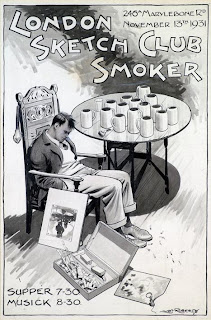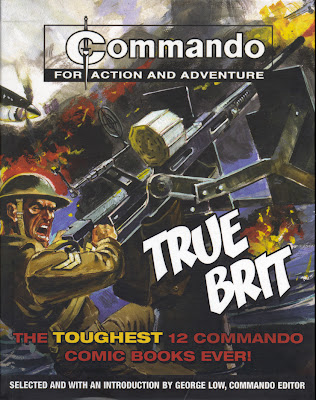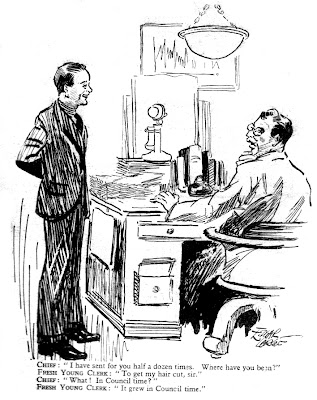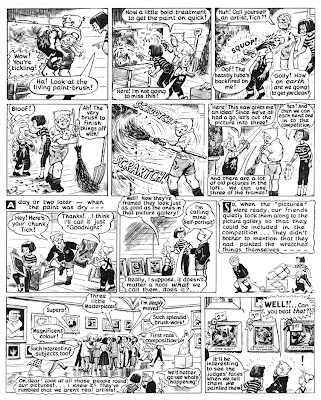
For those of you still following these ramblings, I'm still working my way through the more obscure artists who contributed to
Swift Annual.
Today's artist is William Nickless. Born in Essex in 4 April 1902,
Nickless left school at 14 and was working for an agency by the age of 18. He joined the staff of Motor magazine in 1920, producing technical drawings and, later, general figure work. He left to become a freelance artist, illustrating books and occasionally writing them himself. He started his own publishing imprint, Virgin Press, producing limited editions of his own poetry and a series of anti-war etchings which were reproduced in New Leader in 1939.
In the 1940s Nickless illustrated the 'Worzel Gummidge' books of Barbara Euphan Todd and he continued to produce illustrations, mostly for children's books, until his death. Nickless also contributed illustrations to Eagle Annual as well as Swift Annual. You can usually spot his illustrations by his ornate, swirly 'N' that he signed his work with (you can see it in the lower left corner of the illustration above).
Nickless lived in London until 1958 when he moved to Rotherfield, Sussex. His hobbies included making models and musical instruments. He died in early 1977.
Update -- 2 February 2007
Richard Sheaf has kindly dropped me a line with further details following his comment (see comments) about an article in Eagle Times. There was indeed a piece by William Rudling (now editor of Jeff Hawke's Cosmos) in vol. 7 no. 3 (Autumn 1994) in which he mentions contacting a former neighbour of Will Nickless named Betty Thomson, who recalls "He was a large man with a pipe clenched in his teeth and a warm friendly aura." When he was not working from his drawing board, which was mounted on a Victorian mahogany table, he was curing tobacco leaves coated with honey for added aroma; or making a model of a Great Western Railway engine of the Victorian period.
Rudling writes, "His studio overlooked the Sussex countryside and from this vantage point he pursued his interest in astonomy, using a reflecting telescope he had constructed."
According to Rudling, Nickless had an ambition to be an artist even as a youngster growing up in Oak Village near Hamstead. He had to bow to his father's wishes and joined an engineering factory in Acton but kept up his drawing and eventually becoming an artist working at Gameges, the department store, where he drew illustrations for their mail order catalogue.
He then joined Temple Press, working on their magazines The Motor, Aeroplane, Motor Cycling and Commercial Motor. Here he met Nellie Carter, whom he married in 1926; their son, also named Will, was born in 1928.
Nickless went freelance in 1940, working for various magazines, including the Radio Times, and advertising agencies. He also developed an interest in music during the war years, taking up the violin which led him to making several himself.
His 'Owlglass' series of books, featuring anthropamorphised animals and published in 1964-68, was inspired by his living at Heathfield House, a Victorian house hidden within the Wealden forest.
Some of the information in Rudling's article was derived from correspondence with Nickless' son.
 Books
Books
A Guide to the Tower. A poem. London, Virgin Press, 1947.
The Little Fly and other verses. London, Virgin Press, 1957.
Reginald and Spindlesticks; or, Who Killed Cock Robin?, newly translated from the original by W.N. Rotherfield, Nellie & Will Nickless, 1961.
Owlglass, illus. by the author. London, John Baker, 1964.
The Nitehood, illus. by the author. Edinburgh & London, Oliver & Boyd, Sep 1966.
Molepie, illus. by the author. London, Baker, 1967.
Dotted Lines, illus. by the author. London, J. Baker, 1968.
Illustrated BooksThe Dwarf Who Was Much Too Clever by Geoffrey Lang. London, Herbert Jenkins, 1945.
The King Who Was Cold by Geoffrey Lang. London, Herbert Jenkins, 1945.
Worzel Gummidge Again by Barbara Euphan Todd. London, Hollis & Carter, 1946.
The Mouse and the Cuckoo in the Clock byh William Glynne Jones. London, Charles Skilton, 1947.
Worzel Gummidge and Saucy Nancy by Barbara Euphan Todd. London, Hollis & Carter, 1947.
The Ugly Duckling by Hans Christian Andersen. West Drayton, Penguin Books, 1948; Boston, Houghton Miflin Co., 1948.
Bullen of the "Brigadier" by Peter Wickloe. London & Glasgow, Blackie & Son, 1949.
Missing, Believed Lost by Percy F. Westerman. London & Glasgow, Blackie & Son, 1949.
Worzel Gummidge Takes a Holiday by Barbara Euphan Todd. London, Hollis & Carter, 1949.
David Cameron's Adventures by George Clarke. London & Glasgow, Blackie & Son, 1950.
The Thirty-Nine Steps by John Buchan. London, University of London Press, 1951.
Tom Brown's Schooldays by Thomas Hardy; introduction by Lord Elton. London & Glasgow, Collins, 1953.
Adventures at Hampton Court by Violet Needham. London, Lutterworth Press, 1954.
The Adventures of Pinocchio, and Pip, or, the Litte Rose-Coloured Monkey by Carlo Lorenzini; with an introduction by David Davis. London & Glasgow, Collins, 1954.
Dead Man's Cave by Conon Fraser. London & Glasgow, Blackie & Son, 1954.
Gulliver's Travels by Jonathan Swift. London & Glasgow, Blackie & Son, 1954.
Lost in the Outback by Phyllis Mary Power. London & Glasgow, Blackie & Son, 1954.
The Story of the Golden Fleece [adapted from
The Heroes by Charles Kingsley] by M. W. Jennings. London & Glasgow, Blackie & Son, 1954.
Allan Quatermain by H. Rider Haggard; with an introduction by Roger Lancelyn Green. London & Glasgow, Collins, 1955.
The Aztec Temple by Andrew Wood. London & Glasgow, Blackie & Son, 1955.
Ghost Canyon by John Kennett. London & Glasgow, Blackie & Son, 1955.
The Green Dragon by Conon Fraser. London & Glasgow, Blackie & Son, 1955.
King Solomon's Mines by H. Rider Haggard. London & Glasgow, Collins, 1955.
Lion's Gold by Geoffrey Field. London & Glasgow, Blackie & Son, 1955.
The Mystery Skater of St. Michael's by Ena Grayson. London & Glasgow, Blackie & Son, 1955.
Valley o' Bones by James Shaw. London & Glasgow, Blackie & Son, 1955.
Emma by Jane Austen, simplifield by Michael West & E. P. Hart. London, Longman, 1956.
The Princess and Curdie by George Macdonald. London & Glasgow, Collins, 1956.
The Princess and the Goblin by George Macdonald. London & Glasgow, Collins, 1956.
Shadow of Danger by Conon Fraser. London & Glasgow, Blackie & Son, 1956.
Ayesha by H. Rider Haggard. London & Glasgow, Collins, 1957.
Nada the Lily by H. Rider Haggard; with an introduction by Edward Boyd. London & Glasgow, Collins, 1957.
She by H. Rider Haggard. London & Glasgow, Collins, 1957.
The Sign of the Glove by Hoole Jackson. London & Glasgow, Blackie & Son, 1957.
The Underground Explorers by Conon Fraser. London & Glasgow, Blackie & Son, 1957.
The Waters of Chance by Howard Apps. London & Glasgow, Blackie & Son, 1957.
Across Canada by Joyce Boyle. London, Longmans, 1958.
The Master Key by Jessie Maclehose. London & Glasgow, Blackie & Son, 1958.
The Return of Robinson Crusoe by Henry Treece. London, Hulton Press, 1958.
Dundi Shah -- Beloved Princess by Anne Westwood. London & Glasgow, Blackie & Son, 1959.
The Flower of the Forest by Cecily M. Rutley. London & Glasgow, Blackie & Son, 1959.
Mystery on Majorca by Joan Mary Bate. London & Glasgow, Blackie & Son, 1959.
Nursing in the Outback by Phyllis Mary Power. London & Glasgow, Blackie & Son, 1959.
Ponies for Sale by Alan Jenkins. London & Glasgow, Blackie & Son, 1959.
The Ranch Riders by Cecily M. Rutley. London & Glasgow, Blackie & Son, 1959.
The Underground River by Conon Fraser. London & Glasgow, Blackie & Son, 1959.
Heidi by Johanna Spyri; translated by M. Rosenbaum; with an introduction by Noel Streatfield. London, William Collins & Sons & Co., 1960.
Jungle Picnic by Anne Westwood. London & Glasgow, Blackie & Son, 1960.
Lim of Hong Kong by Conon Fraser. London & Glasgow, Blackie & Son, 1960.
Troubled Waters by Maurice Wiggin. London, Hutchinson, 1960.
A Christmas Carol; and, The Cricket on the Hearth by Charles Dickens, simplified by Michael West. London, Longman, 1961.
The Dagger and the Rose by Aubrey Feist. London, Heinemann, 1961.
Tales of King Arthur by Mary Cathcart Borer. London, Longmans, 1961.
Aesop's Fables, and fables by others. London, Ward Lock & Co., 1962.
Oliver Twist by Charles Dickens; abridged by Latif Doss. London, Longmans, 1962.
The Swiss Family Robinson by Johann Wyss; simplified by Michael West. London, Longmans, 1962.
Comprehension Cards by John Buchan. London, University of London Press, 1963.
The Story of the Church by Gordon Albion. London, Burns & Oates, 1963.
My Life on Wheels by Maurice Wiggin. London, John Baker, 1963.
Stories of Famous Sea Fights by Frank Knight. Edinburgh & London, Oliver & Boyd, 1963.
Stories of Famous Ships by Frank Knight. Edinburgh & London, Oliver & Boyd, 1963.
Ali Baba and the Forty Thieves. London, (Favourite Book), 1964.
The House Through the Trees by Marie Joseph. London, Thomas Nelson & Sons, 1964.
Stories of Famous Explorers by Sea by Frank Knight. Edinburgh & London, Oliver & Boyd, 1964.
The Baxter Family by Jenny Taylor. London & Glasgow, Blackie, 1965.
Classic Thrillers. A teenage book of famous stories, ed. Eric Duthie; illus. with Barrie Linklater. London, Odhams Press, 1965.
Stories of Famous Explorers by Land by Frank Knight. Edinburgh & London, Oliver & Boyd, 1965.
The Black Arrow by Robert Louis Stevenson; simplified by Michael West. London, Longmans, 1966.
A Boys' Treasury of Sea Stories. London & New York, Hamlyn, 1966.
Stories of Famous Sea Adventures by Frank Knight. Edinburgh & London, Oliver & Boyd, 1966.
Stories of Famous Sea Explorers by Frank Knight. Edinburgh & London, Oliver & Boyd, 1966.
The Donkey Walk by James Richards. London, Icon Books, 1967.
Happy Venture by Fred J. Schonell & Irene Sarjeant. Edinburgh, Oliver & Boyd, 1967.
Girls' Adventure Stories of Long Ago. Feltham, Hamlyn, 1968.
The Battle of Britain, August-September 1940 by Edward Fox. London, Lutterworth Press, 1969.
The Field of Waterloo, June 18, 1815 by Aubrey Feist. London, Lutterworth Press, 1969.
Fishes of the World by Allan Cooper; illus. with George Thompson. Feltham, Hamlyn, 1969.
Rivers and River Life. London, Macdonald Educational, 1971.
David Livingstone by Neil Grant. London, F. Watts (Discover Books), 1974.
(* The illustrations are from
Swift Annual 1962 and
1963 and are
© Look and Learn Magazine Ltd.)
 Edward Dudley Pout was born at Frog Island Farm,
Edward Dudley Pout was born at Frog Island Farm,  From 1952, he concentrated on drawing strips for Girl, where his work included 'Tess and the Mystery Journey' (1953), 'Pat of Paradise Island' (1953-54), the 'Vicky' series (1954-58) and 'Angela Air Hostess' (1958-61).After these two very successful strips, Pout continued to draw for Girl for another two years ('Sally of the Seven Seas', 1961; 'Prince of the Pampas', 1961; various biographical strips, 1961-62) but, mindful of the decline in sales and concern for his wife's poor health, was forced to leave comic strips behind.
From 1952, he concentrated on drawing strips for Girl, where his work included 'Tess and the Mystery Journey' (1953), 'Pat of Paradise Island' (1953-54), the 'Vicky' series (1954-58) and 'Angela Air Hostess' (1958-61).After these two very successful strips, Pout continued to draw for Girl for another two years ('Sally of the Seven Seas', 1961; 'Prince of the Pampas', 1961; various biographical strips, 1961-62) but, mindful of the decline in sales and concern for his wife's poor health, was forced to leave comic strips behind.















































































